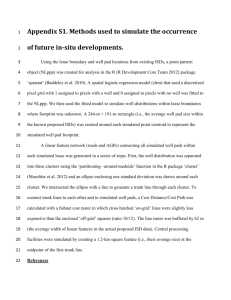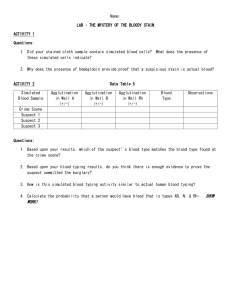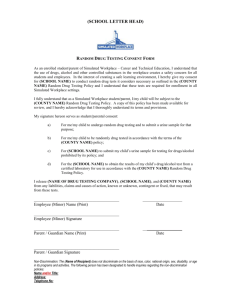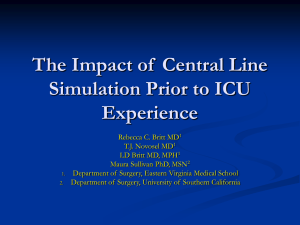Supplementary Material revised
advertisement
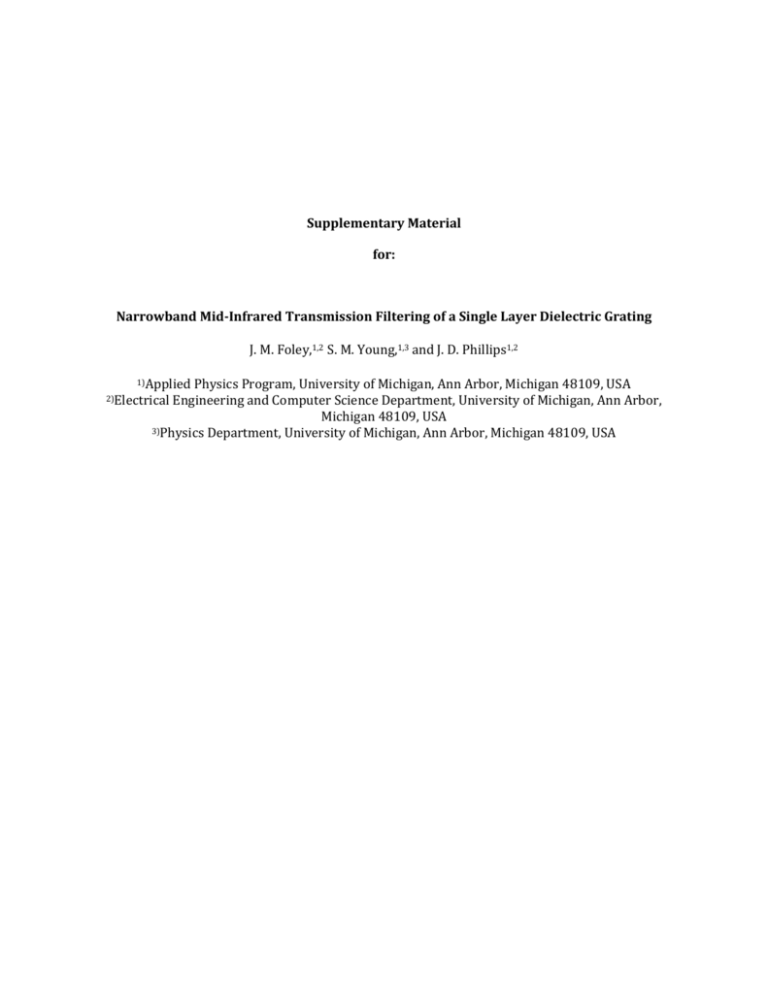
Supplementary Material for: Narrowband Mid-Infrared Transmission Filtering of a Single Layer Dielectric Grating J. M. Foley,1,2 S. M. Young,1,3 and J. D. Phillips1,2 1)Applied Physics Program, University of Michigan, Ann Arbor, Michigan 48109, USA Engineering and Computer Science Department, University of Michigan, Ann Arbor, Michigan 48109, USA 3)Physics Department, University of Michigan, Ann Arbor, Michigan 48109, USA 2)Electrical S1. Reflectance and Transmittance Computational Methods COMSOL Multiphysics RF Module was used to simulate the reflectance and transmittance responses of the suspended grating structures assuming the optical properties of bulk silicon from literature.1 Figure S1 shows the computational domain with boundaries and dimensions defined. Figure S1. Computational domain consisting of one period with Floquet and port boundary conditions defined S2. Fano Resonance Fitting The simulated response was fit with a Fano-lineshape according to R r 2 ( 0 ) 2 t 2 (1/ ) 2 2rt ( 0 )(1/ ) . ( 0 ) 2 (1/ ) 2 where r and t are the reflection and transmission coefficients dictated by the relation r2 t2 1, is the frequency, 0 is the central frequency at resonance and is the resonance lifetime.2 We assumed two fitting parameters: and r . Figure S2 shows the simulated response and fit to Fano-lineshape with fitting parameters included. Figure S2. Simulated resonant response (red) and Fano-fitting (green) in reflectance mode with simulated parameters: Λ=4.9 μm, t=2.85 μm, h=4.05 μm, FF=72% and θ=5˚, for a) the lower order mode ((ii) in the main text) and b) the higher order mode ((i) in the main text). S3. Bandwidth and Quality Factor We extracted the quality factor and bandwidth for both experimental and simulated responses. The bandwidth was calculated assuming 50% of the peak transmittance, or full width half maximum (FWHM). Figure S3 summarizes the quality factor ( Q / ) and FWHM analysis of the structure with: Λ=4.9 μm, t=2.85 μm, h=4.05 μm and FF=72%. Figure S3. Experimental (red) and as-built simulated (blue-dotted) response bandwidth analysis of a representative structure with Λ=4.9 μm, FF=0.72, t=2.85 μm and h=4.05 μm for a) the higher order resonance ((i) in the main text) and b) the lower order resonance ((ii) in the main text). Lines indicating the FWHM for experimental (green-dashed) and simulated (blue-dashed) are overlaid. The peak wavelength for each dataset is provided with s and e subscripts used for simulation and experiment, respectively. S4. Angular Dependence The resonances exhibit dependence on incident angle due to the slope of the dispersion relation and coupling strength. Figure S4 includes simulated values of the peak transmitted wavelength and bandwidth of the lowest order resonance as a function of increasing angle, θ. For angles smaller than 5˚ from normal the change in the peak wavelength is less than 50 nm or 0.5% of the filtered wavelength. Subsequent 5° increments lead to approximately 100 nm deviations each. The FWHM dependence is shown in Figure S4b, where a FWHM of less than 200 nm is expected for incident angles smaller than 10° from normal incidence. Figure S4. The lowest order resonant wavelength dependence on incident angle for a) the peak filtered wavelength and b) bandwidth The 2 mm aperture permitted a range of angles between 6˚ and 12˚ with a central angle of 9˚. This range in angles leads to broadening of the resonant peak. Figure S5 shows the corresponding simulated response for each angle with experimental response overlaid. Figure S5. Experimental (red) and simulated (dotted) responses at a) the smallest angle permitted by the aperture (6°), b) the central angle (9°) and c) the largest angle permitted by the aperture (12°) S5 Experimental and Simulated Response of Figure 4 Figure S6 includes the experimental and simulated data (at 9° from normal) of main text Figure 4 with grating parameters: Λ=4.7-5.1 µm, FF=72% µm, t=2.85 µm and h=4.05 µm. Figure S6. Experimental (red) and as-built simulated (blue-dotted) responses of suspended structures with: Λ=4.7-5.1 μm, FF=0.72, t=2.85 μm and h=4.05 μm at 9° from normal. S6 Transverse Electric Response Figure S7 shows the polarization dependence of a grating including experimental and simulated response. Figure S7. Grating response for transverse electric (TE) polarized incident light with: Λ=4.9 μm, FF=0.72, t=2.85 μm and h=4.05 μm at 9°. a) Experimental transmittance for TE polarized incident light (black-dashed) and TM polarized incident light(red). b) Simulated (blue) and experimental (black-dashed) transmittance for TE polarized incident light. 1 2 Palik, E. D. Handbook of optical-constants. Journal of the Optical Society of America a-Optics Image Science and Vision 1, 1297-1297 (1984). Fan, S. H., Suh, W. & Joannopoulos, J. D. Temporal coupled-mode theory for the Fano resonance in optical resonators. Journal of the Optical Society of America a-Optics Image Science and Vision 20, 569-572, doi:10.1364/josaa.20.000569 (2003).


